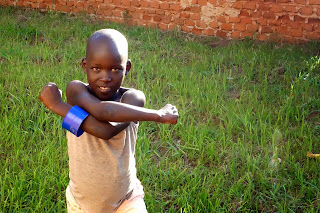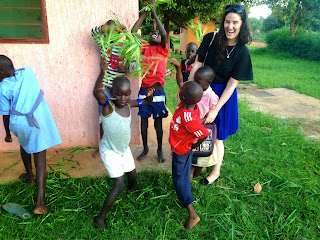I find it impossible to believe, let alone
type, that my time in Gulu is up. Three months absolutely flew.
I made the long arduous journey down to
Kampala yesterday, having woken up late with a sore head from the farewell
party, and had to sit on the bus for two long hours (waiting for it to fill up)
before it departed. As I sat there waiting, I looked out on the street and
thought to myself that Gulu is truly the ugliest place I’ve ever seen –
potholed and dilapidated, a thick sheet of red dust caking every surface, foot-wide
gutters framing the streets traversed with planks of wood and full of plastic
bottles and rubbish. There are no sights to see (the only landmark is an iron
statue on a roundabout), and the Lonely Planet actually goes so far as to say
you should not even bother going there. It is literally the only time I’ve ever
seen a travel book advise you to not travel
somewhere.
Niamh O’Grady sent me a voice message the
first day I arrived and said she couldn’t wait to discuss what an eye-sore the
place was. She was absolutely right. But looking out the dirty window of the
ancient bus I was sitting on I really felt an overwhelming sadness leaving
behind that eye-sore. It really was home for three months. I knew the many
cracks in the pavement. I knew the best place to get a Rolex. I knew that you
could only buy eggs on Egg Street, behind the bus park (and even then, some days
there were no eggs to be found as if the hens all stopped laying at once).
I would like to say there’s some hidden
charm to the place but there really isn’t. There is nothing in Gulu that an
eager traveller would want to see, to tick off their bucket list or take a
selfie with (didn’t stop me though!). Contrary to the Lonely Planet’s advice,
coming here was the best decision I ever made. In this ugly duckling of a town
I’ve experienced so much more than I could have hoped, I have made lifelong
friendships and learned so much about myself and others along the way.
 |
| Note from the patient's family (names covered for confidentiality) |
My friend Sophie works in Gulu referral
hospital and told me about one of her patients. He is 27 years old and is
paralysed from the waist down from Pott’s disease (spinal tuberculosis). When his
family was released from the internal displacement camp after the civil war in
Northern Uganda, they, like the two million other Acholi people had to rebuild
their lives from scratch. He and his father decided in his early teens that he
would leave school and work, so that the younger two siblings could have a good
education and make something of themselves. So he worked. No doubt partially
due to his poor and truncated education, he contracted HIV and then TB. The TB
paralysed him at 27, while his siblings are both healthy and well, studying law
and medicine. And he is not one bit angry or bitter, he doesn’t complain or
moan. Sitting immobile in his hospital bed he is genuinely content, accepting
and happy for his siblings. His story broke my heart. To me he is the
definition of sacrifice and selflessness. He is a hero. But nobody really
celebrates him, because here in Uganda the family simply comes first and his
story is probably not all that unusual. He needed some money to alter his
wheelchair a bit, so I happily and eagerly gave some of the donations from home
(the equivalent of €30) and his family sent the loveliest letter of thanks.
 |
| Selling chickens through windows! |
 |
| Ugandan drive-thru |
As the bus rattled down the potholed road
toward Kampala I looked around and noticed I was the only person wearing
earphones. I was the only person with a book. All around me the Ugandans
chatted and joked and laughed. This is something I noticed throughout my time
here – there is nothing they enjoy more than each other’s company. Perfect
strangers will strike up a conversation on the matatu (minibus) into town. Security guards and shopkeepers will have a
five-minute chat with you enquiring after your health and your family if you’d
give them the time of day. It’s no wonder things move so slowly when everyone
is sitting back smelling the roses! As Mary Ann put it, it is really very
difficult to get annoyed with colleagues for being so slow when you see them
truly enjoying each other’s company and savoring their friendships. I really
loved the days in theatre when it wasn’t too busy, the patients were stable and
everyone would kick back and have the craic. One day we spent an hour discussing
everyone’s first kiss. Even the patient told his story as the surgeon fixed his
hernia under spinal anaesthesia. The nurses in the ICU said they could hear us
roaring laughing way down the corridor. I learned during my time here I could
smell the roses like the rest of them – definitely something we could all learn
from Uganda!
 |
| Ruth taking a casual rest during a prostatectomy |
 |
| Lacor mural at night |
The atmosphere in Lacor hospital is
special. It was set up by the Comboni missionaries in 1959, and became home to
Canadian surgeon Lucille Teasdale and her Italian husband Piero Corti in 1961.
Together they worked tirelessly for the people of Gulu for almost 40 years.
Tragically Lucille died of AIDS contracted during surgery in 1996, and Piero died
not long afterward from pancreatic cancer. One of the first ever Ugandan interns
who trained at Lacor, Dr Matthew Lukwiya, like so many other staff members at
Lacor risked his life to treat patients during the Ebola epidemic in 2000 and
sadly succumbed to the haemorrhagic fever himself. These three heros all chose
to be buried at Lacor and we are reminded of them every time we walk through
the front gates, greeted by a large mural of their smiling faces, lit up at
night to remind us the door is always open for the sick and needy. During the
insurgence, Lacor became home to tens of thousands of night commuters, mainly
women and children who wandered into the compound every night for shelter and safety
from the Kony’s LRA rebels and government troops. Within Gulu, Lacor hospital
is a symbol of goodness, and any adults old enough to remember them speak
fervently and reverently about its past heroes, grateful for the sacrifices
made for their community. The spirit of goodness and generosity continues today,
not only among the Ugandan staff but with new heroes like Ray, who has spent 12
years developing the ICU and department of anaesthesia, saving thousands of
lives; Mary Ann who now runs the HIV/AIDS clinic and cancer chemotherapy
services; Brother Carlo who has spent 40 years as a radiologist in Uganda, and
of course Brother Elio who essentially unofficially runs the place and is
rumoured to be the only mere mortal feared by Joseph Kony. The pride in the
hospital’s history is palpable and tangible and I am so happy and grateful to
have been a part of it.
 |
| Baboons! |
I saw the usual baboons along the roadside
as I crossed the Nile for the last time. Shortly afterward we made another
drive-thru pitstop where local villagers sold snacks to us through the windows
of the bus. An amazing selection of mangoes, pineapples, meat sticks, samosas,
G-nuts and simsim. One guy was even selling live chickens (which a man beside
me bought so we had a furry friend for the rest of the journey). We passed by
clusters of mudhuts and fields of maize and bananas. The bus driver definitely
had a prostate problem as he jumped out for a ‘short-call’ every half hour or
so, always pausing to greet the locals en route back to the bus. It was dark
when we finally reached Kampala and the traffic was chaotic. It had taken me
ten hours to get there, instead of the normal six and I realised surprisingly I
wasn’t even annoyed. Like my fellow passengers I knew we’d get there eventually
and sure isn’t that the main thing?
 |
| Children around Lacor |
I really have had the most incredible time
here. I met mountain gorillas, I saw baby lions ten metres away, I whitewater
rafted down the Nile and stood on the equator. But these are not the memories
that will make me smile when I’m back home dreaming of Africa. It’ll be the
image of the grown man wearing a Hilary Duff t-shirt. It’ll be knowing there is
a doctor here who’s actual name is Dr Happy Betty. It’ll be the nurses taking a
nap in theatre. It’ll be me answering to the name Pharrell. The Ugandan woman I saw in town one day wearing a Kerry jersey. The two girls who
get up on stage and lip-sync Westlife in Butterflies every Friday night,
without fail. The quizmaster in BJz announcing ‘OK you people, question
number..next’. The little old Acholi ladies beaming when you greet them in
their own language. All things that would never make their way into the Lonely
Planet, yet made my time here priceless, unique and unforgettable. And I’m
sitting here in Entebbe airport, right back where the adventure started three
months ago. As I try to clean off the last of the red road dust from my
converse I find I can’t. It’s stuck there - now a constant reminder of the ugly
duckling, the eye-sore that welcomed me with open arms and taught me so much. A
truly life-changing experience. Thank you for supporting and reading.
 |
| Francis and I |
 |
Dr Ocen and patient who was bitten by a
black manta snake: 3 days later |
 |
| St Mary's Hospital Lacor |
 |
| Few wee quiet tears at Entebbe airport :( |























































